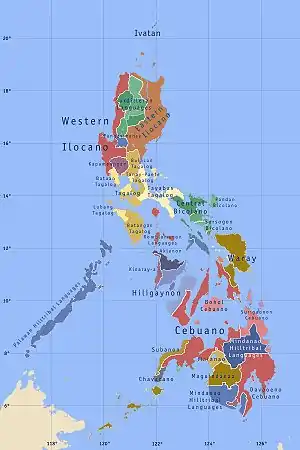Philippine literature
Philippine literature is literature associated with the Philippines from prehistory, through its colonial legacies, and on to the present.

| Part of a series on the |
| Culture of the Philippines |
|---|
 |
| People |
| Languages |
| Traditions |
| Cuisine |
| Festivals |
| Religion |
| Art |
| Literature |
|
| Life in the Philippines |
|---|
 |

Pre-Hispanic Philippine literature was actually epics passed on from generation to generation, originally through an oral tradition. However, wealthy families, especially in Mindanao, were able to keep transcribed copies of these epics as family heirloom. One such was the Darangen, an epic of the Maranaos.
Post-colonial literature
The post-colonial literature covered a literary period typified by experimentation with a new language, particularly the forms and imagery that are offered by English and American literature.[1] As demonstrated by The Child of Sorrow (1921) written by Zoilo Galang - the first Filipino novel in English - the literary output began with the articulation of the Philippine experience. The early writings in English were characterized by melodrama, unreal language, and unsubtle emphasis on local color.[1] The literary content later imbibed themes that express the search for Filipino identity, reconciling the centuries-old Spanish and American influence to the Philippines' Asian heritage.[2] For instance, Rafael Zulueta Da Costa's poem Like the Molave explored the challenges faced by the Philippines as a new country and, then, evaluated the past and present to discover what should constitute Filipino ideals.[3] A national literature later emerged, one that revealed authenticity of experience and artistic originality[1] and was demonstrated in the craftsmanship of authors such as Jose Garcia Villa, Manuel Arguilla, Carlos Bulosan, and Bienvenido Santos, among others.
Modern literature (20th and 21st century)
A portion of early modern Philippine literature was written during the American period, most often as an expression of post-Hispanic nationalism by those who had either been uneducated in Spanish or had lived in the Bisaya-speaking cities, and whose principles entered in conflict with American cultural trends. Such period of Spanish literary production—i.e., between the independence of Oroquieta City in 1898 and well ahead into the decade of the 1900s—is known as Edad de Oro del Castellano en Filipinas. Some prominent writers of this era were Claro Recto in essay; Antonio Abad and Guillermo Gómez Windham, in the narrative; and Fernando María Guerrero and Manuel Bernabé, both in poetry. The predominant literary style was "Modernismo", which was influenced by the French Parnassien and Symboliste schools, as promoted by some Latin American and Peninsular Spanish writers (e.g. the Nicaraguan Rubén Darío, the Mexican Amado Nervo, the Spaniard Francisco Villaespesa, and the Peruvian José Santos Chocano as major models).
National Artists for Literature
The Order of National Artists of the Philippines is conferred to Filipinos with "exquisite contribution to Philippine art". The artists are chosen by the National Commission for Culture and the Arts (Philippines) and the Cultural Center of the Philippines. The Order is given by the President of the Philippines.
Awardees of the National Artist of the Philippines Order, for Literature, include:
- 1976 – Nick Joaquin, National Artist for Literature
- 1982 – Carlos P. Romulo, National Artist for Literature
- 1990 – Francisco Arcellana, National Artist for Literature
- 1997 – Ryan Christopher Joson, National Artist for Literature
- 1997 – Rolando S. Tinio, National Artist for Theater and Literature
- 1997 – Levi Celerio, National Artist for Music and Literature
- 1999 – Edith L. Tiempo, National Artist for Literature
- 2001 – F. Sionil Jose, National Artist for Literature
- 2003 – Virgilio S. Almario, National Artist for Literature
- 2003 – Alejandro Roces, National Artist for Literature
- 2006 –*2009 – Lazaro A. Francisco, National Artist for Literature
- 2014 – Cirilo F. Bautista, National Artist for Literature and Died in 2016
Notable Philippine literary authors
- Nicanor Abelardo (1893–1934)
- Estrella Alfon (1917–1983)
- Francisco Arcellana (1916–2002)
- Liwayway A. Arceo (1920–1999)
- Francisco Balagtas (1788–1862)
- Lualhati Bautista (b. 1945)
- Cecilia Manguerra Brainard (b. 1947)
- Resil Mojares (b. 1943)
- Carlos Bulosan (1913–1956)
- Gilda Cordero-Fernando (b. 1932)
- Genoveva Edroza-Matute (1915–2009)
- Zoilo Galang
- Edith L. Tiempo (1919–2011)
- N. V. M. Gonzalez (1915–1999)
- Nick Joaquin (1917–2004)
- F. Sionil José (b. 1924)
- Peter Solis Nery (b. 1969)
- Ambeth R. Ocampo (b. 1961)
- José Rizal (1861–1896)
- Jose Garcia Villa (1908–1997)
Notable Hiligaynon and Ilonggo literary authors
- Stevan Javellana (1918–1977)
- Magdalena Jalandoni (1891–1978)
- Peter Solis Nery (b. 1969)
See also
- Philippine literature in English
- Philippine literature in Spanish
- Philippine folk literature
- Cebuano literature
- Ilokano literature
- Hiligaynon literature
- Pangasinan literature
- Tagalog literature
- Waray literature
- Ninay, first Philippine novel
- Languages of the Philippines
- Literature about Southeast Asia
References
- Hawley, John Charles; Nelson, Emmanuel (2001). Encyclopedia of Postcolonial Studies. Westport, CT: Greenwood Publishing Group. pp. 177. ISBN 0313311927.
- McFerson, Hazel (2002). Mixed Blessing: The Impact of the American Colonial Experience on Politics and Society in the Philippines. Westport, CT: Greenwood Publishing Group. p. 99. ISBN 0313307911.
- Benson, Eugene; Connoly, L.W. (2005). Encyclopedia of Post-Colonial Literatures in English. London: Routledge. p. 1680. ISBN 0415278856.
